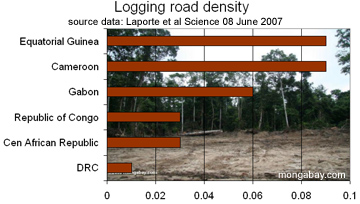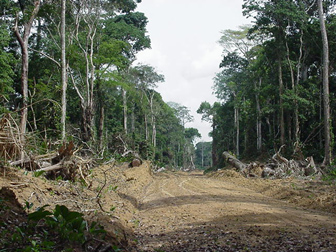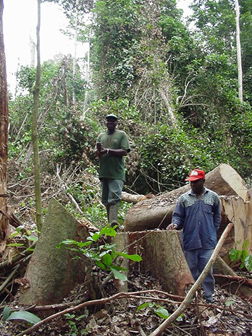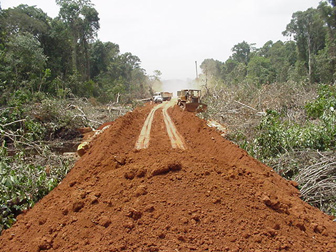Logging roads rapidly expanding in Congo rainforest
Logging roads rapidly expanding in Congo rainforest
mongabay.com
June 7, 2007
Logging roads are rapidly expanding in the Congo rainforest, report researchers who have constructed the first satellite-based maps of road construction in Central Africa. The authors say the work will help conservation agencies, governments, and scientists better understand how the expansion of logging is impacting the forest, its inhabitants, and global climate.
Analyzing Landsat satellite images of 4 million square miles of Central African rainforest acquired between 1976 and 2003, a team of researchers led by Dr. Nadine Laporte of the Woods Hole Research Center (WHRC) mapped nearly 52,000 km of logging roads in the forests of Cameroon, Central African Republic, Equatorial Guinea, Gabon, Republic of Congo, and Democratic Republic of Congo (DRC). They found that road density has increased dramatically since the 1970s and that around 29 percent of the remaining Congo rainforest was “likely to have increased wildlife hunting pressure because of easier access and local market opportunities” offered by new logging towns and roads.
“Roads provide access, and this research provides clear evidence that the rainforests of Central Africa are not as remote as they once were
.a bad thing for many of the species that call it home,” said Jared Stabach, a researcher at WHRC and a co-author of the paper.
Roads appearing fastest in Republic of Congo, but DRC is next frontier
 Logging road density in Congo countries. |
The authors report that the highest logging road densities were in Cameroon and Equatorial Guinea, while the most rapidly changing area was in northern Republic of Congo (Brazzaville), where the rate of road construction more than quadrupled–from 156 kilometers per year to over 660 kilometers–between 1976 and 2003. The scientists found evidence of new frontier of logging expansion in DRC, which has just emerged from nearly a decade of civil war.
“It has never been timelier to monitor forest degradation in Central Africa because there is still an opportunity to make a significant difference in reducing the amount of deforestation. The Democratic Republic of Congo contains most of the remaining forest and is the last frontier for logging expansion in Africa,” said Laporte.
Selective cutting still damaging; certification offers hope

Central African rainforest road. Photo by Nadine Laporte. Road constructed through swamp forest to reach the Loudougou concession in Northern Congo. Photo by Nadine Laporte. Monitoring the expansion of logging in last dense humid forest of Central Africa is not only important for biodiversity conservation but also for climatic change. Industrial logging in Central Africa is the most extensive land use with more than 30 percent of the forest under logging concession and the clearing of these forests could significantly increase carbon emissions. -Woods Hole Research Center |
The authors note that more than 600,000 square kilometers of forest are presently under logging concessions, while just 12% of the area is protected. Most logging in the area is focused on selective harvesting of high-value tree species, like African mahoganies, for export, rather than clear-cutting.
Laporte says that selective cutting is increasingly driven by demand from European firms for certified timber, a trend that could eventually slow forest loss and degradation in Central Africa.
“In central Africa, Reduced Impact Logging (RIL) has been adopted by many companies during the past 5 years under the pressure of European markets for certified wood,” Laporte told mongabay.com. “It has definitely improved logging operations of large European logging companies; most of them have now adopted forest management plans, though small companies are still behind, struggling with the associated costs… [and] maybe just lack of interest, since they can sell non-certified wood to Asia and other countries that do not care much about certification.”
“I think that the future of many tropical forests is linked to our success of making people in Asia and elsewhere supportive of certification,” she continued. “Education is key, and the media can play an important role. The info is there, but we need to reach the big consumers.”
Logging and the bushmeat trade
A number of studies have linked logging roads to the bushmeat trade. In April, Science reported higher incidence of elephant poaching in close proximity to logging roads, while a May 2006 Conservation Biology study showed that roads and associated hunting pressure reduced the abundance of a number of mammal species including duikers, forest elephants, buffalo, red river hogs, lowland gorillas, and carnivores in the tropical forests of Gabon. Commercial hunting to meet market demand in cities and overseas is a greater threat than subsistence hunting.
Laporte says that simple rules can reduce impact of logging roads on wildlife including: closing the logging road to traffic following the timber harvesting; establishing checkpoints to look for illegal bushmeat or ivory; banning logging roads near protected areas; and providing alternative sources of protein (such as fish ponds) to workers in logging camps.

Ayous loggers in Congo. Photo by Nadine Laporte. |
Broader implications of the logging road study
Laporte and colleagues say the study will help policymakers and scientists better assess logging expansion in Central Africa as well as the potential impact of logging on global warming emissions.
“Africa is poised for irreversible change, so it is important to help African countries with tools to monitor what is happening to their forests.” said co-author Scott Goetz, a senior scientist at WHRC.
“This work helps to provide key data to local scientists, allowing them the tools needed to work with policy makers to help manage their forests, and in the process reduce biodiversity loss and carbon emissions from deforestation,” added Laporte.
CITATION: Nadine T. Laporte, Jared A. Stabach, Robert Grosch, Tiffany S. Lin, Scott J. Goetz (2007). Expansion of Industrial Logging in Central Africa. Science 8 June 2007.
